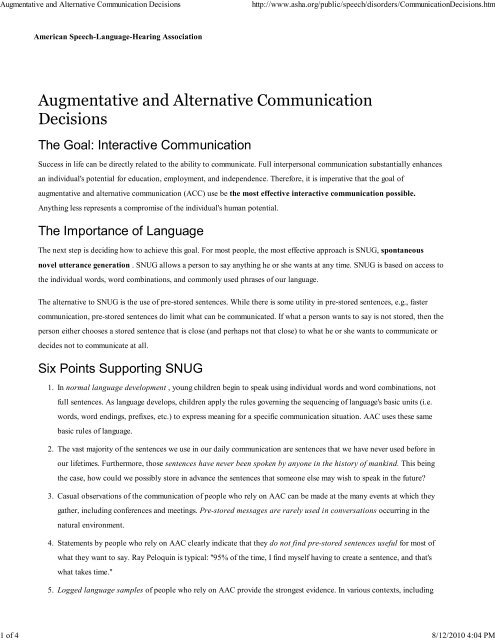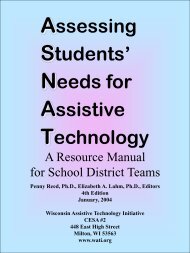Augmentative and Alternative Communication Decisions
Augmentative and Alternative Communication Decisions
Augmentative and Alternative Communication Decisions
Create successful ePaper yourself
Turn your PDF publications into a flip-book with our unique Google optimized e-Paper software.
<strong>Augmentative</strong> <strong>and</strong> <strong>Alternative</strong> <strong>Communication</strong> <strong>Decisions</strong> http://www.asha.org/public/speech/disorders/<strong>Communication</strong><strong>Decisions</strong>.htm<br />
American Speech-Language-Hearing Association<br />
<strong>Augmentative</strong> <strong>and</strong> <strong>Alternative</strong> <strong>Communication</strong><br />
<strong>Decisions</strong><br />
The Goal: Interactive <strong>Communication</strong><br />
Success in life can be directly related to the ability to communicate. Full interpersonal communication substantially enhances<br />
an individual's potential for education, employment, <strong>and</strong> independence. Therefore, it is imperative that the goal of<br />
augmentative <strong>and</strong> alternative communication (ACC) use be the most effective interactive communication possible.<br />
Anything less represents a compromise of the individual's human potential.<br />
The Importance of Language<br />
The next step is deciding how to achieve this goal. For most people, the most effective approach is SNUG, spontaneous<br />
novel utterance generation . SNUG allows a person to say anything he or she wants at any time. SNUG is based on access to<br />
the individual words, word combinations, <strong>and</strong> commonly used phrases of our language.<br />
The alternative to SNUG is the use of pre-stored sentences. While there is some utility in pre-stored sentences, e.g., faster<br />
communication, pre-stored sentences do limit what can be communicated. If what a person wants to say is not stored, then the<br />
person either chooses a stored sentence that is close (<strong>and</strong> perhaps not that close) to what he or she wants to communicate or<br />
decides not to communicate at all.<br />
Six Points Supporting SNUG<br />
1. In normal language development , young children begin to speak using individual words <strong>and</strong> word combinations, not<br />
2.<br />
full sentences. As language develops, children apply the rules governing the sequencing of language's basic units (i.e.<br />
words, word endings, prefixes, etc.) to express meaning for a specific communication situation. AAC uses these same<br />
basic rules of language.<br />
The vast majority of the sentences we use in our daily communication are sentences that we have never used before in<br />
our lifetimes. Furthermore, those sentences have never been spoken by anyone in the history of mankind. This being<br />
the case, how could we possibly store in advance the sentences that someone else may wish to speak in the future?<br />
3. Casual observations of the communication of people who rely on AAC can be made at the many events at which they<br />
gather, including conferences <strong>and</strong> meetings. Pre-stored messages are rarely used in conversations occurring in the<br />
natural environment.<br />
4. Statements by people who rely on AAC clearly indicate that they do not find pre-stored sentences useful for most of<br />
what they want to say. Ray Peloquin is typical: "95% of the time, I find myself having to create a sentence, <strong>and</strong> that's<br />
what takes time."<br />
5. Logged language samples of people who rely on AAC provide the strongest evidence. In various contexts, including<br />
1 of 4 8/12/2010 4:04 PM
<strong>Augmentative</strong> <strong>and</strong> <strong>Alternative</strong> <strong>Communication</strong> <strong>Decisions</strong> http://www.asha.org/public/speech/disorders/<strong>Communication</strong><strong>Decisions</strong>.htm<br />
clinical <strong>and</strong> natural conversation settings, logged data suggest that individuals communicating at the highest levels use<br />
pre-stored utterances for less than 2% of communication.<br />
6. In an Australian research project, Sue Bal<strong>and</strong>in <strong>and</strong> Teresa Iacono asked speech-language pathologists to predict the<br />
topics that would be useful to employees in a sheltered workshop during breaks. The success rate was dismal, less than<br />
10%. If sentences were pre-stored based on these predicted topics, the sentences would have little relevance to the<br />
actual conversations occurring.<br />
To maximize SNUG, choice of vocabulary is critical to success. Vocabulary can be divided into two vocabulary categories,<br />
core <strong>and</strong> extended . Core vocabulary consists of those few hundred words that constitute the vast majority of communication.<br />
Extended vocabulary consists of the remaining words that are used infrequently. Core vocabulary may have the pragmatic<br />
function of allowing the speaker to maintain participation in a conversation <strong>and</strong> should be accessible automatically for<br />
maximum speed. Vocabulary should be consistent with language age. For example, a normally developing three year old has a<br />
vocabulary of around 1100 words.<br />
Language Representation in AAC Systems<br />
The next decision is the method or methods that will be used to represent language in the AAC system. There are three basic<br />
methods: single meaning pictures , alphabet-based systems , <strong>and</strong> semantic compaction . With single meaning pictures, each<br />
picture means one word. Alphabet-based systems include spelling, word prediction, <strong>and</strong> letter codes. Semantic compaction<br />
(Minspeak) is the only patented system <strong>and</strong> is based on multi-meaning icons.<br />
It is important to know the attributes of these methods. The following chart can help in this underst<strong>and</strong>ing:<br />
SINGLE MEANING PICTURES LITERACY LENGTH OF SYMBOL NUMBER OF<br />
COMBINATION<br />
ALPHABET-BASED SYSTEMS Not required Short Large<br />
SEMANTIC COMPACTION Required Long Small<br />
Not required Short Small<br />
SYMBOLS REQUIRED<br />
Single meaning pictures do not require literacy. By their very nature, the symbol sequence length is short, just one picture.<br />
However, the symbol set is huge for any significant vocabulary. Back to the normally developing three-year-old, a symbol set<br />
of 1100 pictures is needed. An AAC system with, for example, 50 keys would require at least 22 pages of pictures to represent<br />
this vocabulary. Furthermore, almost all words of core vocabulary are not easily represented by pictures. Therefore, the<br />
meaning behind the picture must be taught. To help remember this meaning, at least for users with literacy, most single<br />
meaning picture systems have a word associated with the picture.<br />
Alphabet-based systems do require literacy. The symbol sequences are long. Many letters must be assembled to convey<br />
meaning to the communication partner. This is the downfall of spelling.<br />
AAC systems that can predict words after the first several letters can reduce the number of letter selections, but predictions<br />
are not always correct. Because of this, research shows that the rate of communication is not significantly increased above<br />
spelling the whole word. Also, the word prediction process is said to be distracting <strong>and</strong> cannot become automatic.<br />
Whole word access (spelled word selection) returns to the same difficulty experienced with single meaning pictures. The<br />
2 of 4 8/12/2010 4:04 PM
<strong>Augmentative</strong> <strong>and</strong> <strong>Alternative</strong> <strong>Communication</strong> <strong>Decisions</strong> http://www.asha.org/public/speech/disorders/<strong>Communication</strong><strong>Decisions</strong>.htm<br />
symbol set becomes very large.<br />
Semantic compaction does not require literacy. The symbol sequences are short, typically between one <strong>and</strong> two symbols per<br />
word. The symbol set is small, fitting on a single overlay to the AAC device. This avoids the difficulties associated with<br />
changing overlays or screens. Like single meaning pictures, however, training is required.<br />
Using multiple methods is the choice of many people who rely on AAC. The most effective communicators are highly<br />
consistent on this point. Logged data of their communication indicates that they use semantic compaction for 90-95% of<br />
everything they say (core vocabulary) while the remaining 5-10% (extended vocabulary) is split between spelling <strong>and</strong> word<br />
prediction. This evidence indicates that they make little or no use of single meaning pictures, letter coding, or pre-stored<br />
sentences. More recent analysis of logged data from people who rely on AAC indicates that communication rate for words<br />
selected using semantic compaction is about four times that of those selected using spelling. This may explain why people use<br />
semantic compaction for such a high percentage of communication.<br />
Outcomes<br />
The next step is determining desired outcomes. Outcome measures are objective criteria, usually developed during the<br />
assessment <strong>and</strong> recommendation process that can be used to judge the effectiveness of both devices <strong>and</strong> services. In other<br />
words, what will the chosen device <strong>and</strong> associated services allow the user to communicate in what circumstances? Today, the<br />
use of automated monitoring tools on the device facilitates the quantitative analysis of this performance.<br />
Outcomes cannot be developed until the language representation methods have been chosen. Language representation<br />
methods determine whether an outcome is achievable. For example, use of word prediction to access extended vocabulary<br />
cannot be an achievable outcome on a system that can only use single meaning pictures. Second, current language<br />
development <strong>and</strong> communication competence should be reflected in the identified outcomes. Finally, the outcomes should<br />
reflect long-term commitment to the goal of AAC: interactive communication.<br />
The Technology<br />
From the above decisions, a partial set of specifications for the AAC system can be developed. To this set should be added<br />
considerations like speed of choosing the symbols of the language representation method (selection rate) <strong>and</strong> speed of<br />
communication. Quantitative measurement of selection rate in bits per second assures that this component is optimized. One<br />
must also consider the physical method for selecting the symbols; the output of the selected symbols from the system [e.g., a<br />
highlighted picture (or word, phrase, or sentence) or synthesized speech]; how the device will be moved from place to place<br />
(e.g., carried or mounted on a wheelchair); <strong>and</strong> other areas. Features should be divided into required <strong>and</strong> desirable.<br />
Feature choices based on personal preferences that have little functional application to the chosen language representation<br />
methods should be avoided. Features such as automated language activity monitoring (LAM) allow evidence-based practice to<br />
occur <strong>and</strong> should be included whenever possible.<br />
AAC Devices<br />
Consider only AAC devices that meet the requirements determined in the previous steps. First, include those devices that<br />
support the chosen language representation method(s). From those, choose the devices that have the required technology<br />
features. The final step is to choose the devices that have other desirable traits.<br />
3 of 4 8/12/2010 4:04 PM
<strong>Augmentative</strong> <strong>and</strong> <strong>Alternative</strong> <strong>Communication</strong> <strong>Decisions</strong> http://www.asha.org/public/speech/disorders/<strong>Communication</strong><strong>Decisions</strong>.htm<br />
Performance measurement data can be used to support the team's technology solution <strong>and</strong> provide a starting point for<br />
intervention. The use of this information can strengthen the proposal for funding <strong>and</strong> intervention. The consideration of cost<br />
before this final step suggests a compromise in the personal achievement of the individual <strong>and</strong> is thus inappropriate.<br />
Rehabilitation<br />
Most people who rely on AAC can benefit from the ongoing services of speech-language pathologists <strong>and</strong> other professionals.<br />
Evidence-based practice using observational methods, baseline data collection, language activity monitoring, <strong>and</strong> automated<br />
performance measurement tools yields the most effective results. Today's growth in telerehabilitation services <strong>and</strong> distance<br />
learning are opening up new venues for intervention.<br />
Success!<br />
When people who rely on AAC have the benefit of a methodical <strong>and</strong> scientific process in the selection <strong>and</strong> application of an<br />
AAC system, they also have the highest potential for personal achievement.<br />
Adapted from a paper by Katya Hill, M.A., CCC-SLP, Assistant Professor, Speech-Language Pathology, Edinboro<br />
University of Pennsylvania. Contact her by e-mail at khill@edinboro.edu.<br />
©1997-2010 American Speech-Language-Hearing Association<br />
4 of 4 8/12/2010 4:04 PM











